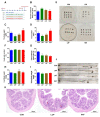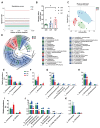Flavonoids in Amomum tsaoko Crevost et Lemarie Ameliorate Loperamide-Induced Constipation in Mice by Regulating Gut Microbiota and Related Metabolites
- PMID: 37108354
- PMCID: PMC10139007
- DOI: 10.3390/ijms24087191
Flavonoids in Amomum tsaoko Crevost et Lemarie Ameliorate Loperamide-Induced Constipation in Mice by Regulating Gut Microbiota and Related Metabolites
Abstract
Amomum tsaoko (AT) is a dietary botanical with laxative properties; however, the active ingredients and mechanisms are still unclear. The active fraction of AT aqueous extract (ATAE) for promoting defecation in slow transit constipation mice is the ethanol-soluble part (ATES). The total flavonoids of ATES (ATTF) were the main active component. ATTF significantly increased the abundance of Lactobacillus and Bacillus and reduced the dominant commensals, such as Lachnospiraceae, thereby changing the gut microbiota structure and composition. Meanwhile, ATTF changed the gut metabolites mainly enriched in pathways such as the serotonergic synapse. In addition, ATTF increased the serum serotonin (5-HT) content and mRNA expression of 5-hydroxytryptamine receptor 2A (5-HT2A), Phospholipase A2 (PLA2), and Cyclooxygenase-2 (COX2), which are involved in the serotonergic synaptic pathway. ATTF increased Transient receptor potential A1 (TRPA1), which promotes the release of 5-HT, and Myosin light chain 3(MLC3), which promotes smooth muscle motility. Notably, we established a network between gut microbiota, gut metabolites, and host parameters. The dominant gut microbiota Lactobacillus and Bacillus, prostaglandin J2 (PGJ2) and laxative phenotypes showed the most significant associations. The above results suggest that ATTF may relieve constipation by regulating the gut microbiota and serotonergic synaptic pathway and has great potential for laxative drug development in the future.
Keywords: Amomum tsaoko; constipation; gastrointestinal motility; gut metabolites; gut microbiota.
Conflict of interest statement
The authors declare no conflict of interest.
Figures






Similar articles
-
Correlations Between Amelioration of Rotenone-Induced Parkinson's Symptoms by Amomum tsaoko Flavonoids and Gut Microbiota in Mice.Int J Mol Sci. 2025 Feb 16;26(4):1676. doi: 10.3390/ijms26041676. Int J Mol Sci. 2025. PMID: 40004140 Free PMC article.
-
Network pharmacology combined with an animal model to reveal the material basis and mechanism of Amomum villosum in alleviating constipation in mice.Gene. 2024 Mar 1;897:148064. doi: 10.1016/j.gene.2023.148064. Epub 2023 Dec 6. Gene. 2024. PMID: 38065427
-
Protective effect of L-pipecolic acid on constipation in C57BL/6 mice based on gut microbiome and serum metabolomic.BMC Microbiol. 2023 May 20;23(1):144. doi: 10.1186/s12866-023-02880-3. BMC Microbiol. 2023. PMID: 37210496 Free PMC article.
-
Amomum tsao-ko Crevost & Lemarié: a comprehensive review on traditional uses, botany, phytochemistry, and pharmacology.Phytochem Rev. 2022;21(5):1487-1521. doi: 10.1007/s11101-021-09793-x. Epub 2022 Jan 10. Phytochem Rev. 2022. PMID: 35035319 Free PMC article. Review.
-
Crosstalk between the Gut Microbiome and Colonic Motility in Chronic Constipation: Potential Mechanisms and Microbiota Modulation.Nutrients. 2022 Sep 8;14(18):3704. doi: 10.3390/nu14183704. Nutrients. 2022. PMID: 36145079 Free PMC article. Review.
Cited by
-
Amomum tsaoko flavonoids attenuate ulcerative colitis by inhibiting TLR4/NF-κB/NLRP3 signaling pathway and modulating gut microbiota in mice.Front Microbiol. 2025 Mar 10;16:1557778. doi: 10.3389/fmicb.2025.1557778. eCollection 2025. Front Microbiol. 2025. PMID: 40130239 Free PMC article.
-
Moringa oleifera leaf alleviates functional constipation via regulating the gut microbiota and the enteric nervous system in mice.Front Microbiol. 2023 Dec 20;14:1315402. doi: 10.3389/fmicb.2023.1315402. eCollection 2023. Front Microbiol. 2023. PMID: 38192287 Free PMC article.
-
Deciphering the Plastome and Molecular Identities of Six Medicinal "Doukou" Species.Int J Mol Sci. 2024 Aug 19;25(16):9005. doi: 10.3390/ijms25169005. Int J Mol Sci. 2024. PMID: 39201691 Free PMC article.
-
Therapeutic Potential of Flavonoids and Flavonoid-Rich Compounds in Irritable Bowel Syndrome.Drug Des Devel Ther. 2025 Jun 6;19:4895-4910. doi: 10.2147/DDDT.S515004. eCollection 2025. Drug Des Devel Ther. 2025. PMID: 40496370 Free PMC article. Review.
-
Preparation of flavonoids from Amomum tsaoko and evaluation of their antioxidant and α-glucosidase inhibitory activities.Food Chem X. 2025 Jan 13;25:102177. doi: 10.1016/j.fochx.2025.102177. eCollection 2025 Jan. Food Chem X. 2025. PMID: 39897968 Free PMC article.
References
-
- Rao W.W., Yang J.J., Qi H., Sha S., Zheng W., Zhang L., Ungvari G.S., Ng C.H., Xiang Y.T. Efficacy and Safety of Traditional Chinese Herbal Medicine for Antipsychotic-Related Constipation: A Systematic Review and Meta-Analysis of Randomized Controlled Trials. Front. Psychiatry. 2021;12:610171. doi: 10.3389/fpsyt.2021.610171. - DOI - PMC - PubMed
-
- Chinese Pharmacopoeia Commission . Pharmacopoeia of the People’s Republic of China. China Medical Science Press; Beijing, China: 2015. (In Chinese)
MeSH terms
Substances
Grants and funding
- 202002AA100005/the major project of science and technology department of Yunnan province
- 2019ZG009/YEFICRC project of Yunnan provincial key programs
- 202305AS350025/Xingdian talent plan of Yunnan Province (Young talents project), and selection projects of high-level scientific and technological talents and innovative team
LinkOut - more resources
Full Text Sources
Research Materials

